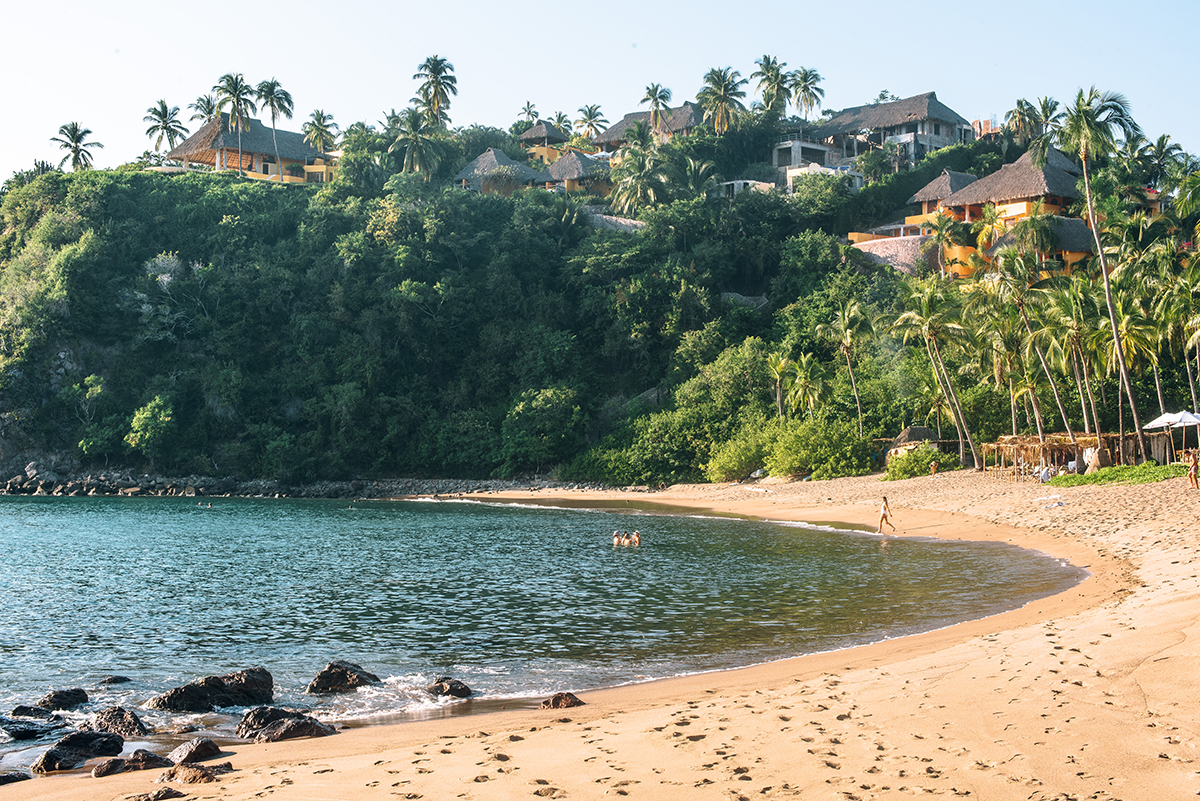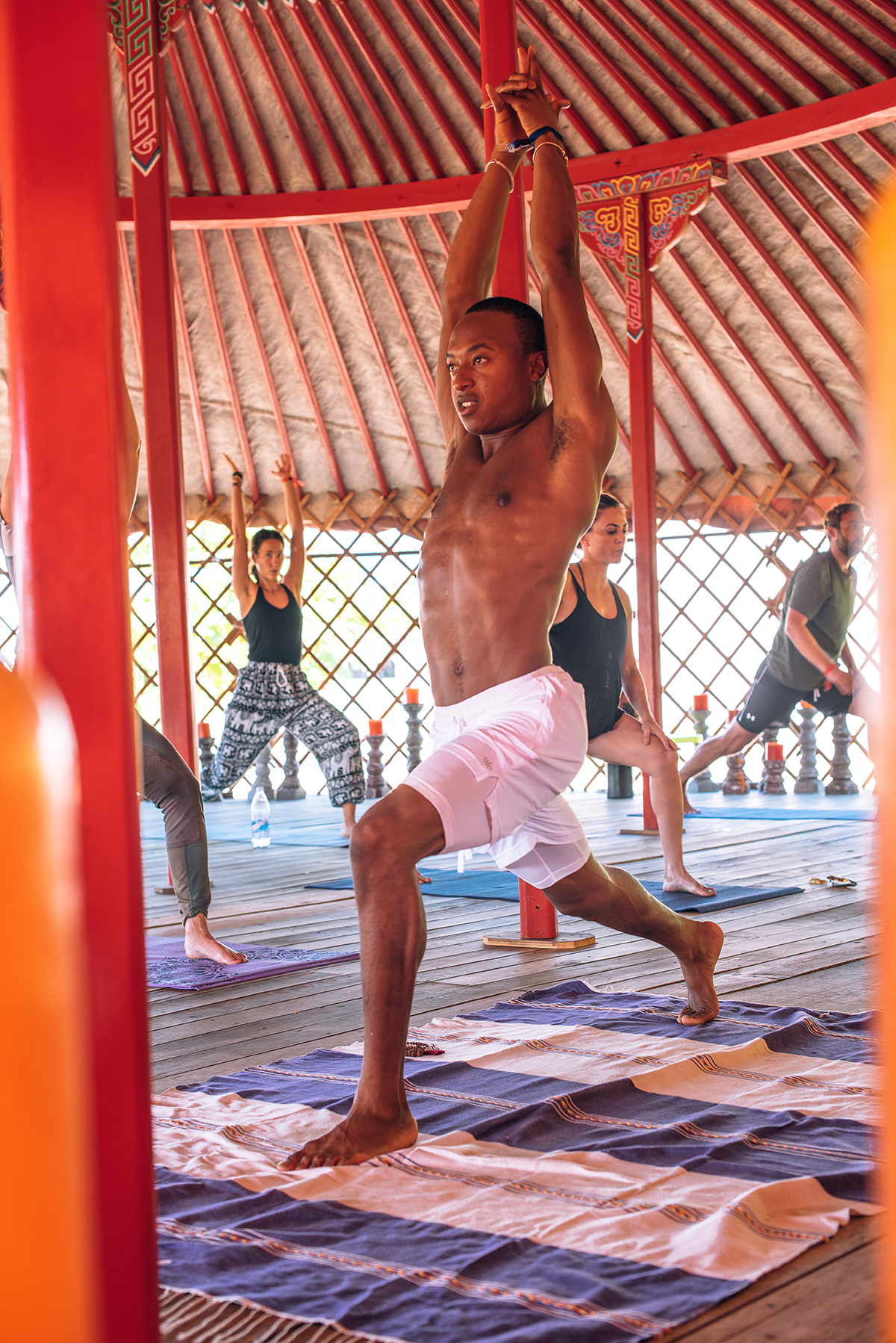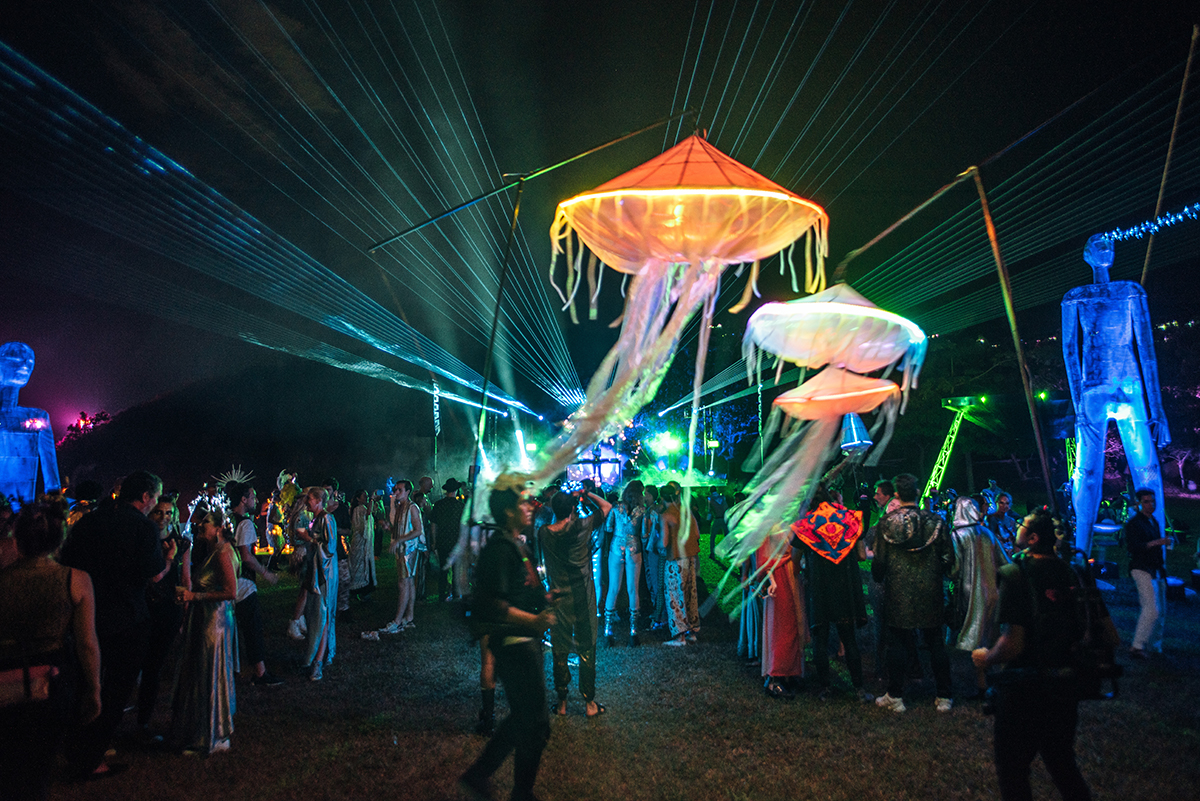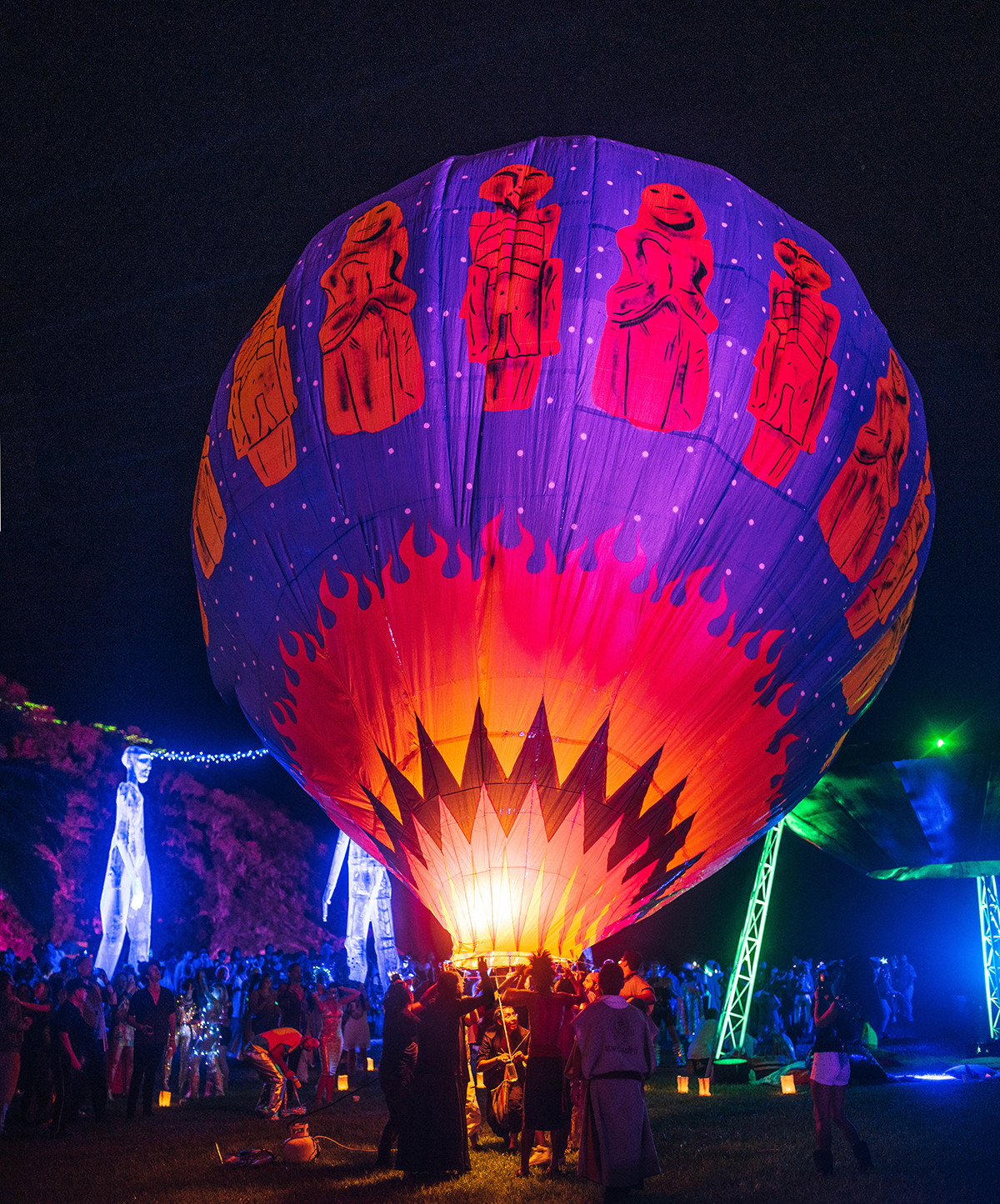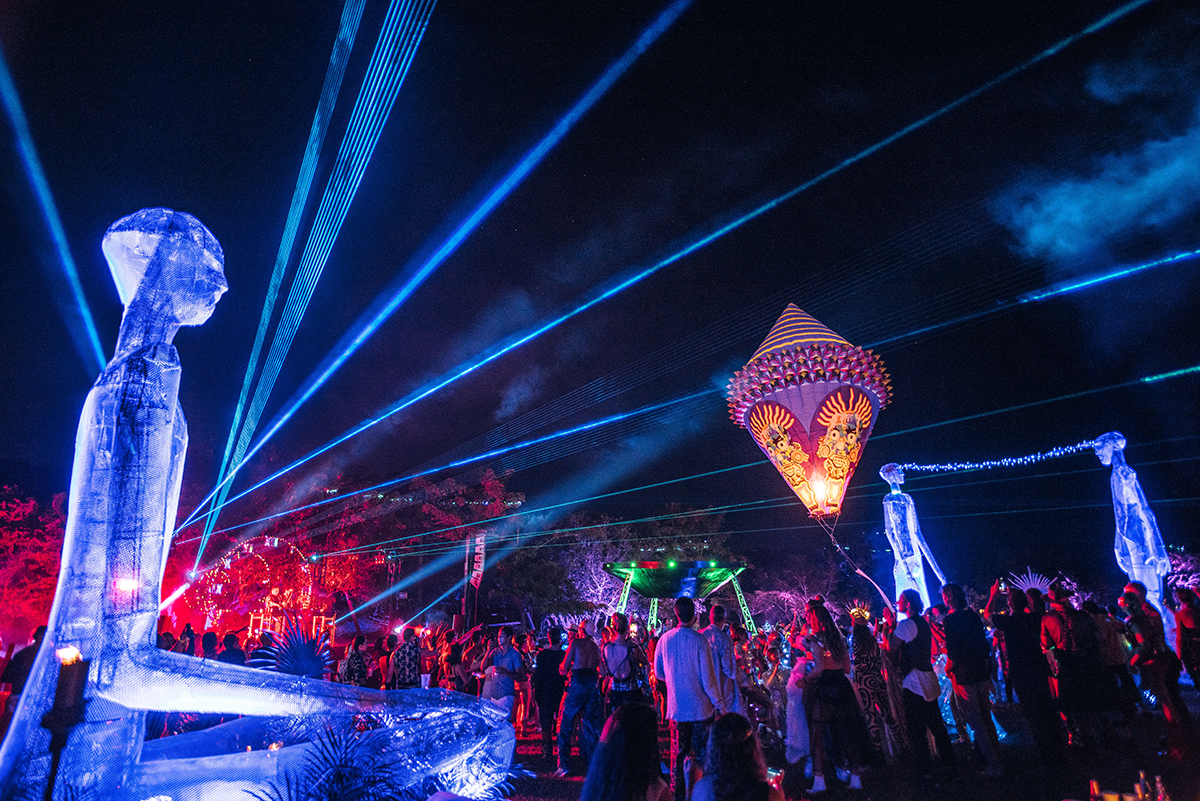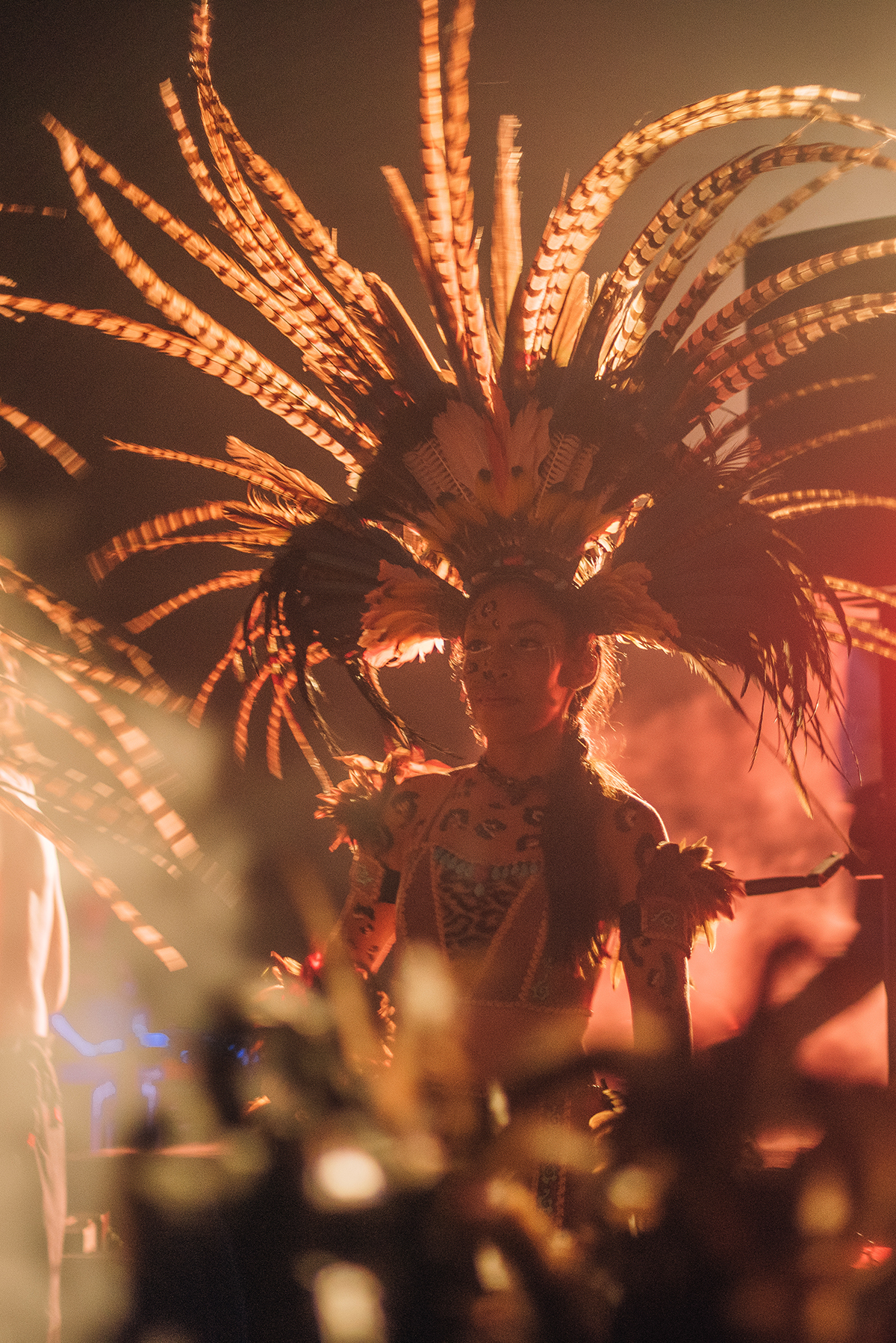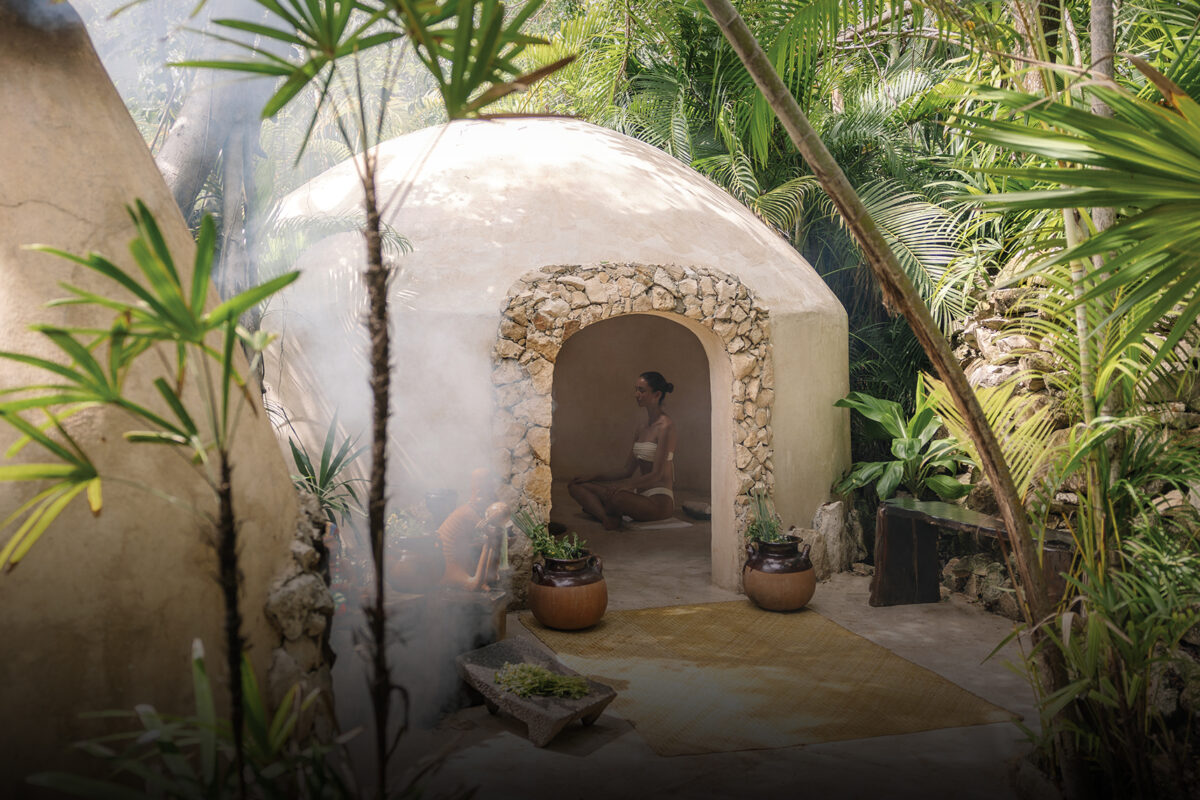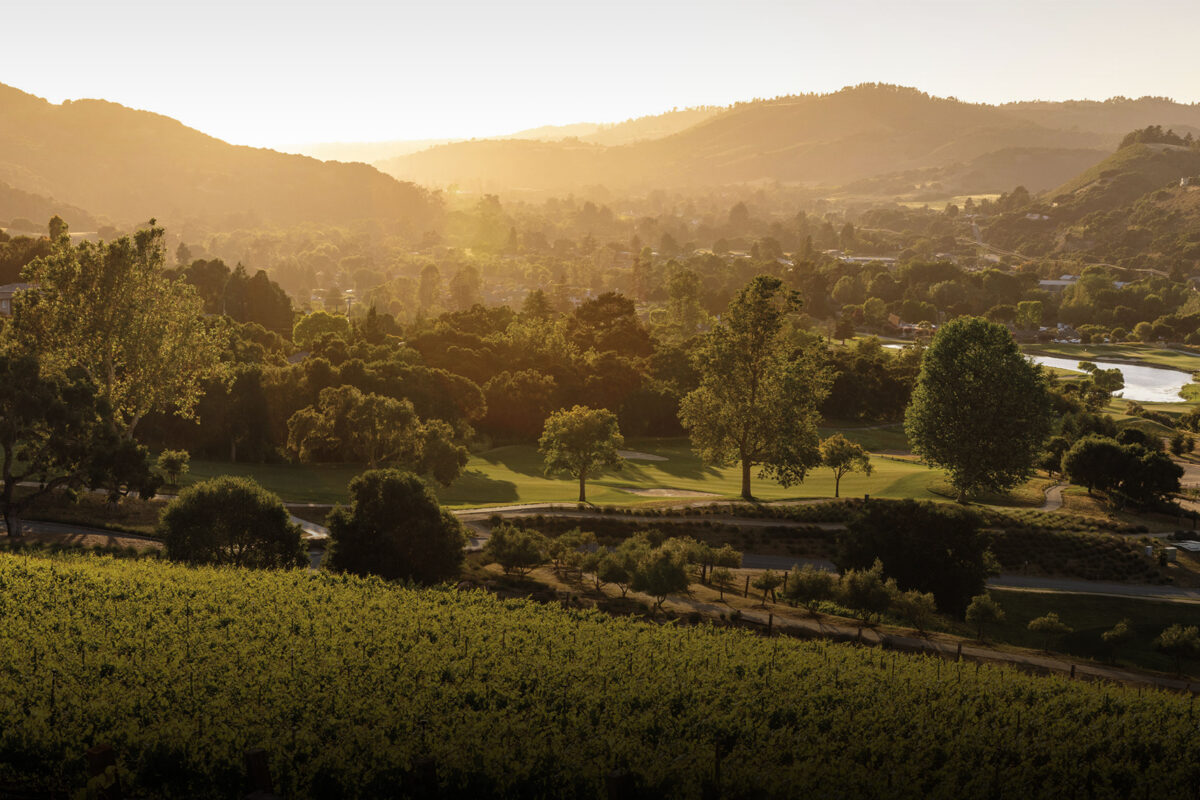Parallel universes collide at the exclusive Ondalinda in stunning Careyes
Words by STACY SUAYA
On the shore of Playa Rosa, a speck of the Jalisco coast of Mexico, there is a tiny hut. Inside are 14 people, crouched over in their bathing suits and covered in mud, without enough room between them to sit cross-legged. Victor Chávez, a medicine man with chestnut brown skin with black curly hair and a practitioner of the ancient sweat lodge-esque ritual of temescal in his village for 36 years, raspily instructs everyone to look to the center at a shallow pit in the dirt ground.
“There are no hotels here, maybe boutiques eventually. We’re never going to have a 300- to 400-room building”
Filippo Brignone
In Spanish, converted to English by a translator, he says, “The mother is the earth, this is her womb, and we honor it.” He lifts a flap of canvas and calls to his tribesman for four molten-hot stones, which arrive one by one on a pitchfork, and are jostled into the pit. Next, a tin bucket of water appears, with a turtle shell the size of a dinner plate inside. Chavez scoops the water, or agua de vida, and douses the rocks, unleashing plumes of steam. He asks for the flap to be closed, and I notice the blond woman across from me has tears rolling down her cheeks. Within minutes, the temperature in the hut will hit 100 degrees and keep climbing.
Temescal is offered two times a day at Ondalinda x Careyes, a four-day arts, music and wellness festival in Costa Careyes, Mexico, that takes place each year in early November. Other offerings include yoga, sundown ceremonies, sound healing, and some of the best parties on the planet right now. This year, the festival’s fourth, held Nov. 9-13, saw such DJ talent as Bob Moses and Lovestrukk, and art installations by Scottish artist Rob Mulholland. The theme was Multiverse (coincidentally, Burning Man 2020 just announced it would have the same theme), a theory that refers to the literal existence of multiple universes. Multiverse begs the question, “What else is out there?” — a question I also had, wondering what I’d have in common with 700 strangers.
Costa Careyes, the eye-popping Mexican playground that’s less than 2 percent developed, is a 20,000-acre nature reserve that was purchased on a whim by Italian banker Gian Franco Brignone in 1968, after he flew over it in a Cessna. At the time, Careyes was a thick jungle with no roads, but the aerial view alone was enough to make him fall in love. The exclusive destination, 5,000 acres stretching along 8 miles of Pacific shoreline, has attracted the likes of Tom Ford, Robert De Niro, Mick Jagger, Francis Ford Coppola, Demi Moore and Uma Thurman to name a slew.
Gian Franco, now 93, had a vision to create a new form of architecture, with rounded, feminine walls of “elephant skin” stucco, reminiscent of the Mediterranean, but with sky-high, palapa-style roofs. He worked with architect Marco Aldaco, a disciple of Pritzker Prize-winning architect Luis Barragán, Diego Villaseñor (who has designed several Four Seasons hotels and private residences throughout Mexico and South America) and Italian modernist Alberto Mazzoni. They built along the breathtaking cliffs, with infinity pools and steep, panoramic views of the Pacific, surrounded by palms, monsteras and 270 species of birds. Today there are just 65 villas in vivid colors like papaya, electric mustard and Yves Klein blue, 40 spacious casitas, three bungalows, the new El Careyes Club & Residences. There are seven alfresco restaurants, and Careyes Polo Club, with two regulation-sized Bermuda grass fields.
“There are no hotels here, maybe boutiques eventually. We’re never going to have a 300- to 400-room building,” says Filippo Brignone, the 64-year-old son of Gian Franco, as he puts out an American Spirit cigarette in a seashell-cum-ashtray, from the patio of his ocean castle villa, Tigre Del Mar, where he now lives full time. “We’re developers who want to be here in 30 to 40 years, and we just want to have some nice people around — there are only 40 of us who live here year-round.” Filippo says the residents are all friends, and they connect for dinner parties, weddings, polo and horseback riding over a WhatsApp chat. “It’s a special formula in Careyes — incredible houses, freedom of space and no problem with noise.”
During the four days and four nights of Ondalinda, I meet a young woman who resembles Jemima Kirke, who grew up in Russia and handles strategic partnerships for nonprofits in San Francisco. Standing on the beach at sunset with an EDM remix of “The Sound of Silence” playing from the adjacent villa, she tells me she just quit her job and is moving to Mexico City without a plan. I ask when. “I’ve got my bags with me right now,” she says.
Whether we are living in an actual multiverse or not, there seemed to be a vast number of universes commingling inside Ondalinda
I meet a yoga instructor and ayurvedic practitioner from Los Angeles who is going through a devastating breakup and recently prayed every day for a sign of what to do now with the aching freedom. He dropped a line into his heart and what came back was that his true love was snowboarding. He thought about Big Sky. Then just like that, a stranger from a Big Sky ski resort called him up and asked if he’d like to do a workshop there. He volleyed back, “What if I moved there?” Now they are in talks to have him lead a new initiative to teach mindfulness to veterans. I speak to a woman from San Miguel de Allende, who, at 40, decided to leave her L.A.-based jewelry design business and move to the colonial Mexican city to open a boutique hotel that she gut-renovated with no prior experience.
In one universe, you could be watching giant hot air balloons, handpainted by the Michoacán tribe in Cherán, Mexico, constructed over a three-month period, being set off into an inky, star-studded sky at 3 a.m.; in another, you might be dancing to a set by DJ Tennis, with half of the crowd in costumes inspired by the night’s dress code (“Meet the Aliens”), an otherworldly whirlwind of sequins, capes strung with fairy lights, LED platform boots and neon green captains hats adorned with UFOs. The other half could be down on the beach, 15 minutes away from being treated to an impromptu fireworks show.
It is rare to see a cellphone out or eye contact not prolonged. There are constant invitations: “Come to our house for dinner/for an after party/for a sunset swim and margaritas.” People tell you that they like your energy, or that they appreciate your economy of words. They pull from the new Malcolm Gladwell book, they talk about the hypocrisy of “brotherhood” in college Greek culture and consent and how they want to bring their kids to Ondalinda to learn about heart-centered celebration. They bring their ideas about modern tribalism, and consider whether we’ve become isolated in our own cities.
“Nobody is chasing cities anymore, they’re chasing communities,” someone tells me. Many talk about how their hearts first cracked open at Burning Man, perhaps at the Temple, where they read left-behind notes about everyone’s traumas and realized that we are all the same. Everyone may be from all over the world, with wildly different life trajectories, but at Ondalinda, everyone seems to be on an equal plane of curiosity and global thinking.
One might think that’s no wonder, after a conversation with Lulu Luchaire, Ondalinda’s founder. Luchaire, 40, founded a beta version of Ondalinda in Cuba in 2015, after President Barack Obama opened travel there from the U.S. She had already lived many lives by this point: After growing up between London and Paris, Luchaire studied Russian Literature in Russia, then philosophy and psychology at La Sorbonne. Then it was neuroscience at ENS Paris, an MBA, working at Credit Suisse and at Apple, and living all over the world. Her last stop before Ondalinda was founding and running an eco-beauty brand in L.A., where she has a home in West Hollywood.
Luchaire had the idea to do a concert that year in Cuba, which mixed art and music and showcased the local culture. She brought in Venezuelan-born, Los Angeles-based DJ/producer Eduardo Castillo to perform, and held it in an art gallery — 120 people came, including Filippo Brignone. Luchaire had first visited Costa Careyes in 2005, and had met Filippo then. Now in Havana, Filippo suggested that Luchaire bring the idea to Careyes, inviting an international audience.
In 2016, the pair, who cycle through English, French and Spanish when talking to each other, co-created and held the first Ondalinda x Careyes and invited 450 of their friends. “It was like a little girl making her own birthday party,” Luchaire says. She adds that her friends have always been her family, and remembers throwing her first party when she was 18 – called Jetlag, it popped up in different venues around Paris and drew 400 community and travel-minded people in its inaugural iteration.
“In my head, everything is picture and sound,” she says, and adds that Ondalinda has always been about the exchange between globe-trotting seekers and native cultures. “Burning Man is a blank canvas — one week there’s a whole city, then it disappears. Ondalinda invites guests to experience the local culture.”
Ondalinda guests are personally invited by Luchaire via email, then must provide references from two people who have already attended the festival. If approved, flights are booked into Playa de Oro or Puerto Vallarta International airports, then require drives of 90 minutes or three hours, respectively. This year, there were 700 attendees. (In contrast, Burning Man totals 70,000.) Guests typically rent the sprawling villas in groups, divvying up the rooms and hiring private chefs for communal meals. Some will host their own sunset parties, or after-parties that follow Ondalinda’s sanctioned parties, where guests arrive by an Ondalinda x Careyes shuttle or private car. A first this year, some attendees also glamped in authentic Mongolian yurts.
The next few nights are held in secret locations, with the DJs becoming more bold-faced, the art installations more over-the-top and the end times more nebulous
Upon arrival, guests are given wristbands and receive all-access to the open bars each evening — sponsored by Silencio Mezcal, Moët Hennessy and Las Terrazas wine. They may also dine in tented areas with picnic-style seating, on buffet-style meals: This year, they are created by three Mexican chefs and one from Argentina. Several of the wellness offerings are also complimentary.
After dinner, the parties commence. The first night everyone dresses in “beach chic,” and the festivities are held at Playa Rosa beach, a porch of sorts for Ondalinda, as many of the wellness activities and a pop-up shop featuring authentic Mexican designers happen here — think caftans, jewelry and handbags of Isabel Marant sensibilities made by women in local villages. There are several DJs and the party ends at 2 a.m., a warm-up night meant for getting to know one another. The next few nights are held in secret locations, with the DJs becoming more bold-faced, the art installations more over-the-top and the end times more nebulous.
On the third night, the afterparty du nuit is held at Sol de Oriente villa, and the dance floor is packed. It’s 5 a.m., and revelers don the night’s dress code, “The Gods of the Heavens and The Guardians of the Underworld,” while beautifully bopping around as though they’re in a Guadagnino film. San Francisco-based Shane One is spinning disco, a character himself with a skinny, bendy frame, wide-brimmed hat and joint-popping dance moves. I retire to a sofa as those behind me stand by the semicircular pool, looking out onto the Pacific and waiting for the sun to come up. I’m exhausted — perhaps from dancing until 3 a.m. the night before, or all of the sweat I’d lost in the temescal.
Earlier that day, at the tiny hut, we had spent 90 minutes in a spiritual experience that involved chanting, absolving ourselves of unwanted energy via flame-deposits of herbs, and so much sweating that hearts beat to the tempo of a ceremonial drum. Afterward, high on our alpha waves, Victor Chávez lifted the canvas flap for a final time and there is an audible exchange of relief. “Close your mouth and eyes,” he instructed, and splashed the faces of each person in the circle with water from his turtle shell. Mud formed rivulets down bellies and thighs. He instructed us to get on our knees and pray. Then the medicine man joked he will forgo using his translator for his closing remarks, and that afterward, the group can teach him English. Everyone laughed.
“But in seriousness, in the future, we will have a common tongue,” Chávez said, frowning. Everyone had a brain-racking look about them. I wonder if there will be a message about indigenous cultures being lost to development. Someone in the group later told me they wondered if the shaman was going to talk about Esperanto, the artificial language invented by combining features of several European languages.
“The common language will be love,” the shaman says, and everyone’s eyes shine. Chávez smiles, and concludes: “Finally, from my people to yours, I want to thank you for this exchange.”
Discover more TRAVEL news.


